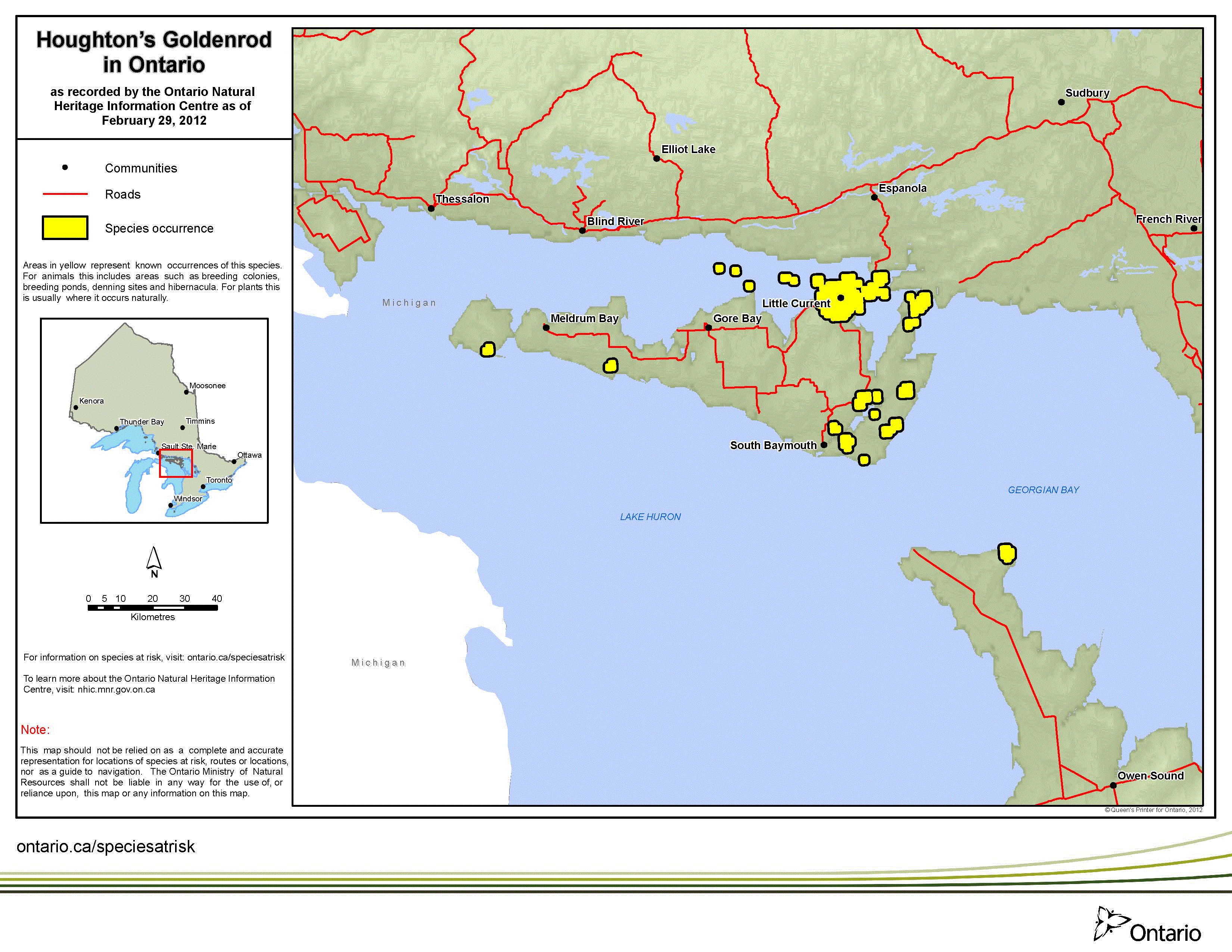Houghton’s goldenrod
Scientific name: Solidago houghtonii

Cover photo credit: Wasyl Bakowsky
Status
Threatened
“Threatened” means the species lives in the wild in Ontario, is not endangered, but is likely to become endangered if steps are not taken to address factors threatening it.
Date added to the Species at Risk in Ontario List
Houghton’s Goldenrod was already assessed as threatened when the Endangered Species Act took effect in 2008.
What it looks like
Houghton’s Goldenrod produces showy, yellow flowers in late summer and early autumn. The smooth reddish stems of this wildflower can reach 30 to 60 centimetres in height.
The lower stem leaves are narrow and long, becoming smaller further up the stem. Houghton’s Goldenrod usually has five to 30 flower heads with 20 to 30 flowers in each.
Where it lives
In Ontario, Houghton’s Goldenrod grows primarily on open alvars, which are barren-looking landscapes of exposed bedrock with very little soil.
This rare habitat is kept relatively open and sunny by natural disturbances, such as drought and fire, which prevent shade-producing shrubs and trees from taking over.
Houghton’s Goldenrod is also found in the relatively low wetland areas between sand dunes associated with Great Lakes shorelines.
Where it’s been found in Ontario
Houghton’s Goldenrod is only found near the Great Lakes of North America.
In Ontario, it is found at Cabot Head at the tip of the Bruce Peninsula and at several sites in the Manitoulin Island area.
Based on surveys done in 2003, the Ontario population is estimated to include 27,000 mature plants.
View a larger version of this map (PDF)
What threatens it
One of the main threats to Houghton’s Goldenrod is habitat destruction due to human activities, such as urban development, habitat alteration and recreational activities.
Road widening has already resulted in the loss of one population. The natural growth of trees and shrubs that shade-out this sun-loving plant is also a serious problem.
At some sites, invasive plants that compete with this plant for light and space are also an issue.
Action we are taking
Threatened Species and their general habitat are automatically protected.
Habitat protection
General Habitat Protection - June 30, 2013
Recovery strategy
A recovery strategy advises the ministry on ways to ensure healthy numbers of the species return to Ontario.
Read the executive summary (June 25, 2015)
Read the recovery strategy (June 25, 2015)
Government response statement
A government response statement outlines the actions the government intends to take or support to help recover the species.
Read the government response statement (March 23, 2016)
Review of progress
A review of progress made toward protecting and recovering a species is required no later than the time specified in the species’ government response statement, or not later than five years after the government response statement is published if no time is specified.
Read the report on progress towards the protection and recovery of 18 species at risk, including Houghton’s Goldenrod (2021).
What you can do
Report a Sighting
Report a sighting of an endangered animal or plant to the Natural Heritage Information Centre. Photographs with specific locations or mapping coordinates are always helpful.
Learn more about reporting wildlife.
Volunteer
Volunteer with your local nature club or provincial park to participate in surveys or stewardship work focused on species at risk.
Be a good steward
- Private land owners have a very important role to play in species recovery. If you find Houghton’s Goldenrod on your land, you may be eligible for stewardship programs that support the protection and recovery of species at risk and their habitats.
- Invasive species seriously threaten many of Ontario’s species at risk. To learn what you can do to help reduce the threat of invasive species, visit:
www.ontario.ca/invasivespecies
www.invadingspecies.com
www.ontarioinvasiveplants.ca - Pollinators, such as bees, are in steep decline across the globe and they play a key role in the survival of many of Ontario’s rare plants. For information on how you can help scientists monitor pollinator populations in Ontario visit:
www.seeds.ca/proj/poll - Houghton’s Goldenrod and many other species at risk depend on healthy grassland prairies, a very rare habitat in Ontario. Learn more about these habitats, the species that depend on them, and what you can do to help at
www.tallgrassontario.org
Report illegal activity
Report any illegal activity related to plants and wildlife to 1-877-TIPS-MNR (847-7667).
Quick facts
- Goldenrod flowers are a magnet for bees and butterflies that feed on nectar and pollen. Many populations of these insect pollinators are declining around the world. You can help prevent the loss of pollinators by planting insect-friendly plants such as goldenrods, Butterfly Milkweed and Yellow Daisy in your garden.
- Houghton’s Goldenrod grows almost exclusively near the north shores of Lake Huron and Lake Michigan
